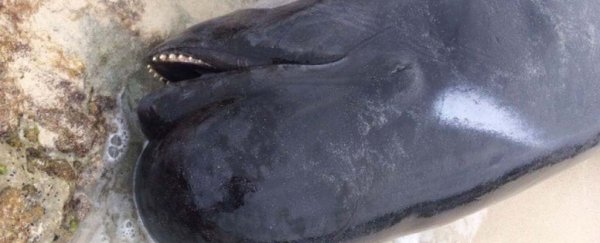More than 150 short-finned pilot whales stranded en masse at Hamelin Bay, 10km north of Augusta, in Western Australia.
About 135 of the whales died after beaching themselves.
Incident controller Jeremy Chick says the main priority is to ensure the welfare of the remaining live whales.
 Short-finned pilot whales stranded on Hamelin Bay beach. (Parks and Wildlife WA)
Short-finned pilot whales stranded on Hamelin Bay beach. (Parks and Wildlife WA)
"The strength of the animals and the windy and possibly wet weather conditions will affect when and where we attempt to move them out to sea," he says.
"The main objectives are to ensure the safety of staff and volunteers as well as the whales' greatest chance of survival."
Attempts to save the whales are proving tricky. As soon as they get pushed out to sea, the tide drags them right back in @abcperth @abcsouthwestwa pic.twitter.com/Xx8PfV8RcN
— Gian De Poloni (@GianDePoloni) March 23, 2018
A hazard from whale strandings is the possibility of increased shark activity.
Culum Brown, an Associate Professor at the Department of Biological Sciences at Macquarie University, says dead whales will certainly attract all kinds of predators and scavengers, including sharks.
"While sharks do not normally target humans, in this context with plenty of food on offer it is likely that anyone in the water will be accidentally bitten," he says.
A mass whale stranding at a beach in Augusta, 315 kilometres south of Perth, has sparked a shark advice alert https://t.co/HAG0mfgqz9 | @abcnews pic.twitter.com/kpNWSnvgyH
— ABC Australia (@ABCaustralia) March 23, 2018
"In general, it is advisable to stay out of the water in contexts where sharks are likely to be feeding: near dead animals, dawn and dusk, near rivers after rainfall and near seal colonies."
The largest mass stranding of whales in Western Australia was in 1996 when 320 long-finned pilot whales stranded at Dunsborough.
Short-finned pilot whales are closely related to long-finned pilot whales, although they have shorter flippers with less of an elbow. Females are about four metres long and males 5.5 metres.
This article was originally published by Business Insider.
More from Business Insider:
